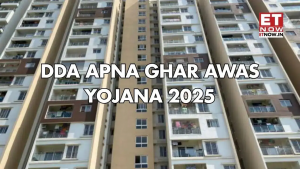Supreme Court Slams Speculative Investors, Calls Them ‘Slow Poison’ for Real Estate

In a landmark ruling, the Supreme Court of India has issued a strong warning against speculative investors in the real estate sector, describing them as a “slow poison” that destabilizes the market. The court drew a clear line between genuine homebuyers and speculative investors, ruling that the latter cannot misuse the Insolvency and Bankruptcy Code (IBC) as a tool for financial gain without any real intention of owning a home.
Also Read: Thinking of Gifting Property to Your Spouse? Here’s What the Tax Rules Say
Why Speculative Investors Are a Threat
- The apex court noted that speculative investors artificially inflate demand, fuel housing bubbles, and undermine the stability of the sector.
- Unlike financial markets where speculation can add liquidity, in residential housing, it only hurts genuine buyers and middle-class families.
- Schemes like assured returns, compulsory buybacks, and excessive exit options were labelled as financial derivatives disguised as housing contracts, enabling investors to exploit developers or invoke IBC unfairly.
Supreme Court’s Observations on Homebuyers’ Plight
- Many middle-class families end up paying both home loan EMIs and rent while their projects remain stalled.
- The court stressed that housing is not a luxury or a commodity but a fundamental human need and an extension of the right to shelter under Article 21.
- It said treating homes as speculative instruments is “thoroughly erroneous.”
Also Read: India’s REIT Market Poised to Cross $25 Billion by 2030: CREDAI-Anarock Report
Key Safeguards and Remedies Proposed
The bench of Justices JB Pardiwala and R Mahadevan outlined several reforms to protect homebuyers and revive stalled projects:
- Strengthening RERA: Authorities must not become “toothless tigers.” They should have proper infrastructure, tribunals, and enforcement powers.
- Timely Completion of Projects: The State has a constitutional duty to ensure that developers cannot defraud buyers and projects are delivered on time.
- Bridge Financing for Stalled Projects: Expand the SWAMIH Fund or create new funds under NARCL to revive viable projects instead of letting them go into liquidation.
- Strict Oversight: CAG audits should track fund usage, with reports made public for accountability.
- Affordable Housing Push: Unsold inventory from stalled projects could be diverted to schemes like PMAY or government housing.
Strengthening Institutional Capacity
- Vacancies in NCLT/NCLAT must be filled urgently, with additional IBC benches created for faster case resolution.
- States must ensure RERA authorities have adequate staff, experts, and resources.
- A high-level reform committee chaired by a retired judge should be set up to recommend systemic changes for real estate credibility.
Rules for Safer Transactions
- Every new residential transaction must be registered with local revenue authorities once 20% of the property cost is paid.
- For early-stage projects, funds from buyers must be kept in escrow accounts and released in phases, as per a RERA-approved SOP.
- Insolvency proceedings should ideally be project-specific, ensuring viable projects are not dragged down with troubled ones.
Also Read: NCLAT Upholds NCLT Ruling, Dismisses Insolvency Plea Against Logix Infrastructure
A Stronger Future for Real Estate
The Supreme Court directed housing boards, urban development authorities, and CPSUs to establish dedicated arms to complete stalled projects under IBC frameworks. It also urged the Centre to create uniform RERA rules across states to bring consistency in regulation.
The ruling concluded with a strong reminder:
“The right to housing is not merely a contractual entitlement but a facet of the fundamental right to life under Article 21. Genuine homebuyers are the backbone of India’s urban future, and their protection is both a constitutional obligation and an economic necessity.”
Page Contents
In a landmark ruling, the Supreme Court of India has issued a strong warning against speculative investors in the real estate sector, describing them as a “slow poison” that destabilizes the market. The court drew a clear line between genuine homebuyers and speculative investors, ruling that the latter cannot misuse the Insolvency and Bankruptcy Code (IBC) as a tool for financial gain without any real intention of owning a home.
Also Read: Thinking of Gifting Property to Your Spouse? Here’s What the Tax Rules Say
Why Speculative Investors Are a Threat
- The apex court noted that speculative investors artificially inflate demand, fuel housing bubbles, and undermine the stability of the sector.
- Unlike financial markets where speculation can add liquidity, in residential housing, it only hurts genuine buyers and middle-class families.
- Schemes like assured returns, compulsory buybacks, and excessive exit options were labelled as financial derivatives disguised as housing contracts, enabling investors to exploit developers or invoke IBC unfairly.
Supreme Court’s Observations on Homebuyers’ Plight
- Many middle-class families end up paying both home loan EMIs and rent while their projects remain stalled.
- The court stressed that housing is not a luxury or a commodity but a fundamental human need and an extension of the right to shelter under Article 21.
- It said treating homes as speculative instruments is “thoroughly erroneous.”
Also Read: India’s REIT Market Poised to Cross $25 Billion by 2030: CREDAI-Anarock Report
Key Safeguards and Remedies Proposed
The bench of Justices JB Pardiwala and R Mahadevan outlined several reforms to protect homebuyers and revive stalled projects:
- Strengthening RERA: Authorities must not become “toothless tigers.” They should have proper infrastructure, tribunals, and enforcement powers.
- Timely Completion of Projects: The State has a constitutional duty to ensure that developers cannot defraud buyers and projects are delivered on time.
- Bridge Financing for Stalled Projects: Expand the SWAMIH Fund or create new funds under NARCL to revive viable projects instead of letting them go into liquidation.
- Strict Oversight: CAG audits should track fund usage, with reports made public for accountability.
- Affordable Housing Push: Unsold inventory from stalled projects could be diverted to schemes like PMAY or government housing.
Strengthening Institutional Capacity
- Vacancies in NCLT/NCLAT must be filled urgently, with additional IBC benches created for faster case resolution.
- States must ensure RERA authorities have adequate staff, experts, and resources.
- A high-level reform committee chaired by a retired judge should be set up to recommend systemic changes for real estate credibility.
Rules for Safer Transactions
- Every new residential transaction must be registered with local revenue authorities once 20% of the property cost is paid.
- For early-stage projects, funds from buyers must be kept in escrow accounts and released in phases, as per a RERA-approved SOP.
- Insolvency proceedings should ideally be project-specific, ensuring viable projects are not dragged down with troubled ones.
Also Read: NCLAT Upholds NCLT Ruling, Dismisses Insolvency Plea Against Logix Infrastructure
A Stronger Future for Real Estate
The Supreme Court directed housing boards, urban development authorities, and CPSUs to establish dedicated arms to complete stalled projects under IBC frameworks. It also urged the Centre to create uniform RERA rules across states to bring consistency in regulation.
The ruling concluded with a strong reminder:
“The right to housing is not merely a contractual entitlement but a facet of the fundamental right to life under Article 21. Genuine homebuyers are the backbone of India’s urban future, and their protection is both a constitutional obligation and an economic necessity.”

L. Sadriwala, the Editor-in-Chief at Housiey, is a seasoned writer whose professional journey in content creation began in 2015. With a background rooted in a family of real estate developers, her transition into real estate writing was a natural evolution, bringing together her storytelling expertise and deep industry understanding.
Over the years, she has authored impactful blogs across diverse niches such as food, travel, and lifestyle, before establishing her reputation as a trusted voice in Indian real estate. Today, her work stands out for its clarity, accuracy, and ability to simplify complex property concepts for readers.
At Housiey, every article crafted by L. Sadriwala reflects thorough research, verified facts, and a reader-first approach. From decoding housing policies and trends to offering in-depth builder reviews and project insights, her mission is clear: to empower homebuyers and investors with the knowledge they need to make confident property decisions.
Her writing not only informs but also builds trust, making her one of the most credible editorial voices in the real estate space.







